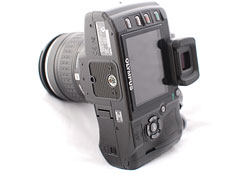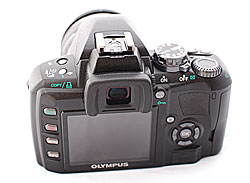 Yesterday we took the Olympus Evolt E-410 Digital SLR Camera in hand and looked at the top plate and lens.
Yesterday we took the Olympus Evolt E-410 Digital SLR Camera in hand and looked at the top plate and lens.
Viewfinder
The prism style viewfinder comes with a comfortable removable rubber eye cup (and dioptre adjustment) but offers a rather tunnel-like view, with the optics considerably smaller than, say, a Nikon D80. Although we moaned about the titchy viewfinder at first, in reality we soon got used to it and it was bright enough to avoid any real usability issues.
As with previous Olympus 4/3 SLRs, the viewfinder offers a centre metering circle, with three AF areas indicated by a red circle after a half-press of the shutter release.
To the right of the focusing screen can be seen a display showing metering mode, shutter speed, aperture, exposure compensation etc using rather old fashioned-looking green LEDs (in the style of the cover of The Police’s ‘Ghost in the Machine’ but without the borked bits).
 The kit lens
The kit lens
Although its bathed in a sea of plastic with a feather-light weight to match (190g), the 28-84 mm equiv. f3.5-5.6 kit lens proved a great carry-anywhere choice providing a useful focal range. We weren’t troubled by any undue purple fringing and the quality was easily a match for the competition.
Pop-up Flash
Boasting an electronic release mechanism, the E-410’s bijou flash gun automatically pops up as required in Auto or Scene modes, and can be manually raised via a small silver button on the top plate (note that the camera has to be turned on for this to work).
The flash has a very modest guide number of 10 and an X-sync speed of 1/180 sec. The E-410 also sports an ‘E System’ flash hot-shoe which offers full automatic control with Olympus dedicated flash units (FL-50, FL-36, FL-20, RF-11 and TF-22), but only sync contact for accept third party units.
Without a dedicated AF assist lamp onboard, you’ll soon get used to the sound of the flash unit popping up in low light.

LCD Screen and a look around the back
The camera comes with a reasonable bright 2.5″ 215,000 pixel LCD monitor that provides decent viewing angles. With no top plate LCD panel, all shooting parameters, preferences, menus and adjustments are carried out via the monitor, which is also used for playback and Olympus’s intriguing Live View mode (see below).
Things are very much kept to the tried and trusted at the back of the E-400, with four buttons to the left of the LCD screen for viewing/deleting images and bringing up info and menus, while to the right there is a 4-way controller with central OK button.
 To the right of the viewfinder is an Auto Exposure/Auto Focus Lock button with a button for activating the Live View mode below.
To the right of the viewfinder is an Auto Exposure/Auto Focus Lock button with a button for activating the Live View mode below.
Card slots and battery
The E-410 uses a fairly small and lightweight 1150mAh Lithium Ion battery pack which slots into the base of the camera and provides reasonable but not spectacular performance (we got around 250 shots, with a moderate amount of battery-champin’ Live View usage).
Above the battery cover and incorporated into the small handgrip is the flap covering the slots for xD-Picture and Compact Flash Type II cards.
On the back of the camera is mini-USB connector providing USB 2.0 and Video Out capability (depending on which of the supplied cables is connected), protected by a rubberised cover. On the base of the camera can be found
a metal tripod socket, nicely lined up with the centre line of the lens.
Look out for Part Three tomorrow.
4 thoughts on “Olympus Evolt E-410 Review: Digital SLR Camera (Part 2)”
Comments are closed.